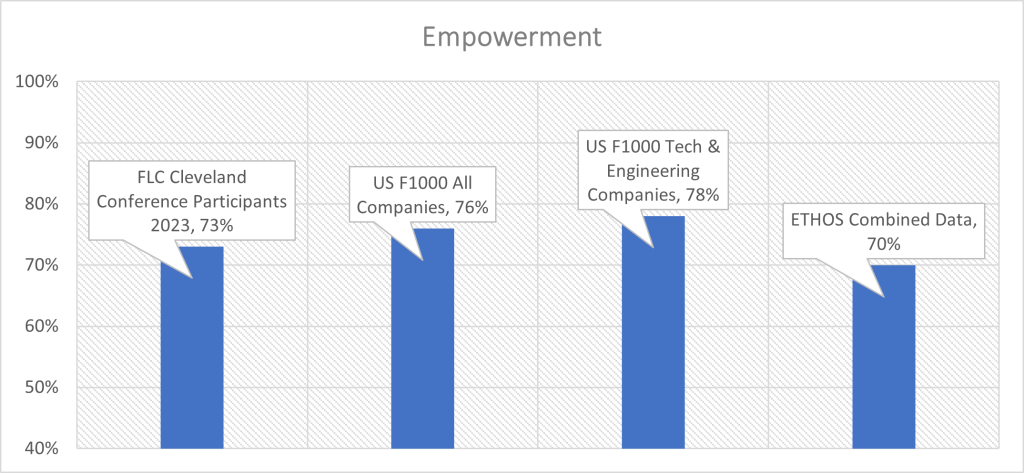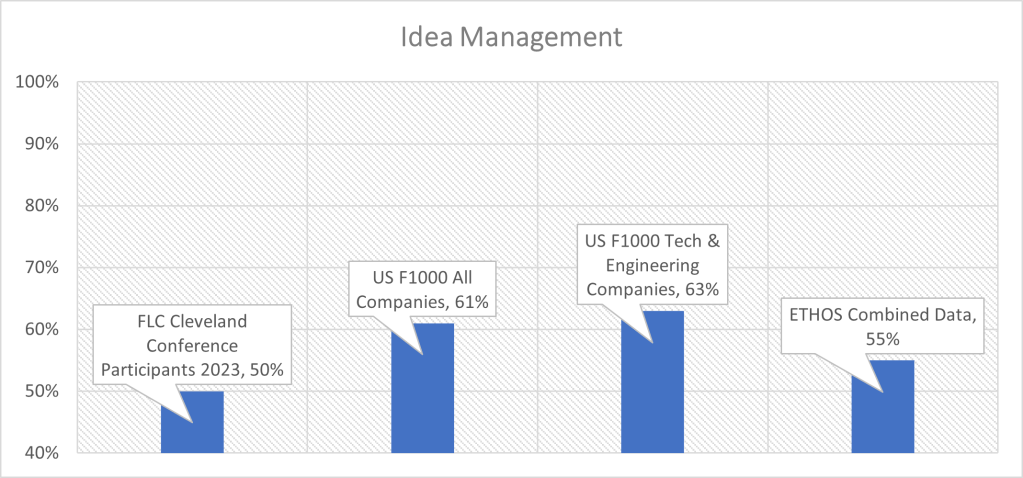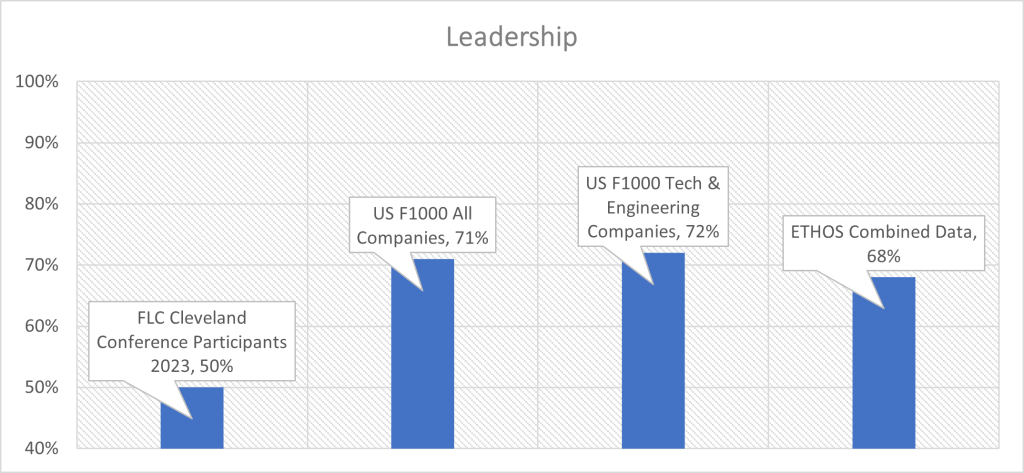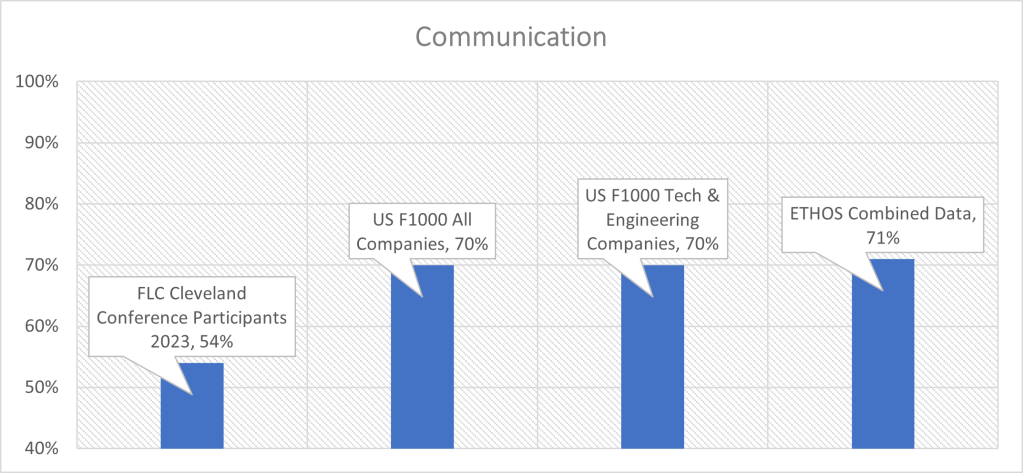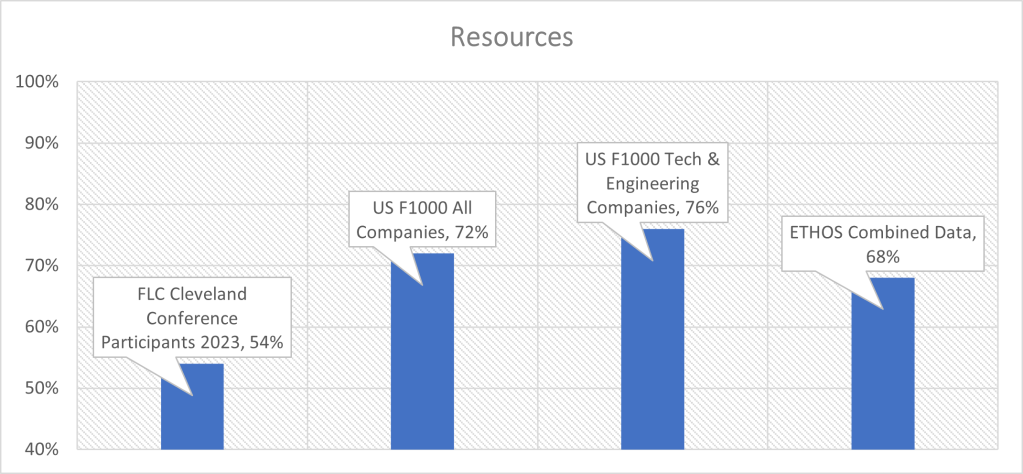Private sector, government research and development (R&D) labs, and attendees at the 2023 Federal Laboratory Consortium for Technology Transfer (FLC) National Meeting held in Cleveland, Ohio, now have empirical guidance from InnovationOne, LLC, on how to develop transparent, learning, and collaborative cultures of innovation.
We show how a focus on just six simple factors can improve an organization’s efficiencies, innovation, and financial success. We will also show how two R&D Lab Groups and another private sector group compare against our top scoring private sector group: the US Fortune 1000 Technology and Engineering (or High Tech) Companies. To learn more about this six factors, click here.
This report by InnovationOne, LLC, was prepared for FLC attendees who attended our workshop in March and answered our six question survey. However, our report has learning for the private industry as well. It compares the levels of innovation exhibited by four distinct groups: the Federal Laboratory Consortium for Technology Transfer (FLC) National Meeting held in Cleveland, Ohio (government funded R&D Labs) in March, 2023, the US Fortune 1000 group of companies, a specific subgroup of the US Fortune 1000 companies consisting of Technology and Engineering Companies, and a group of 6 prominent Department of Energy R&D Laboratories from a research project called ETHOS. By examining six innovation factors for these groups, we can gain valuable insights into the leadership and cultural behaviors for each group and the highest scores..
InnovationOne’s research with the private sector revealed that companies scoring in the top quartile of our InnovationOne Culture Index© reported higher financial performance than bottom quartile performers by as much as 22 percent. Our research with the ETHOS Project shows that higher innovation culture scores improves R&D lab performance. In fact, improving a culture score by just one point (on a 100-point scale) can increase performance in innovation, commercial deployments, partnerships with industry, and academic publications by up to 20 to 30 percent.
InnovationOne, LLC, has benchmarks for other industries, such as finance and insurance, manufacturing, and government agencies. Because of the high scores on the InnovationOne Culture Index© among the US Fortune 1000 Technology and Engineering companies, we use it when drawing comparisons with other groups. (Incidentally, InnovationOne, LLC also has ten country benchmarks.)
The FLC Cleveland Conference Participants are individuals and organizations that participated in the FLC National Meeting held in Cleveland, Ohio in March, 2023. These participants are comprised of researchers, scientists, and technology transfer professionals who work in government laboratories and agencies.
The US F1000 companies are the largest and most successful companies in the United States. By definition, the F1000 represents the largest companies as measured by annual revenue, and generally consist of publicly traded companies. These companies operate in various sectors, including finance, healthcare, retail, and energy. They are known for their innovation and ability to adapt to changing market conditions, which has allowed them to remain at the forefront of their respective industries.
The US F1000 Technology and Engineering companies are a subset of the US F1000 companies that are specifically focused on developing and providing technology and engineering solutions. These companies have a strong track record of innovation.
Lastly, the ETHOS grouping represents data that was collected and aggregated from six prominent UD Department of Energy laboratories..
Each of these three groups are being compared using 6 innovation questions:
- I am empowered to use my creativity for the benefit of the organization.
- The performance management system clearly encourages and incentivizes innovation.
- We have an idea management process that works, that is, if I have an idea, I am aware of a process that can trial this idea quickly and efficiently.
- Our leadership has developed tangible innovation goals that have been communicated across the organization to the point where I understand how I can contribute to innovation.
- Generally speaking, we have an effective environment for communication within and across our divisions in our organization.
- I am given the resources (financial and non-financial), time, and space to pursue innovation.
To determine an overall innovation percentage score for each group and question, the responses to 7-point Likert scale questions were taken and divided by the maximum possible score. This method allows us to obtain an accurate representation of the level of agreement or disagreement with the statements posed and provides a quantitative measure of the groups’ perceptions. Table 1 summarizes the score for each group for each of the six questions.
These six questions represent the common factors that support an innovation culture. In the InnovationOne Culture Index© , these questions represent nearly 80 percent of the variance explained, suggesting that it is an excellent surrogate for the larger innovation measurement assessment model. However, the assessment with more questions will provide more reliable insights and focus areas for action to improve innovation, efficiencies, and financial results across 12 innovation drivers in the organization.
Figure 1: Empowerment
Analysis: This question on employee empowerment is the highest scoring question for the Fortune 1000 High Tech organizations at 78 percent and for the Fortune 1000 at 78 percent. It is a definite strength for the F1000 High Technology and Engineering sector: their employees and teams feel empowered to ask questions, make recommendations, and do their work without significant micromanagement and bureaucracy. It is the strongest score for the FLC cohort at 73 percent and the ETHOS group at 70 Percent. As you will see, the organizations from the FLC cohort will have more significant gaps with the Fortune 1000 and Fortune 1000 Technology and Engineering organizations with the following questions.
Figure 2: Performance Management
Analysis: Performance management is a factor that scores poorly across all groups, meaning that the organization’s goal setting, performance management, and rewards systems do not reward collaboration and innovation. Additionally, these organizations have not aligned their functions (R&D, operations, and sales and marketing) to accelerate their organizations’ commercialization or technology transfer, meaning great innovation may not see the light of day. When the organization’s performance management system does not encourage and incentivize innovation, only the most committed innovators will make suggestions and prototype innovations.
Figure 3: Idea Management
Analysis: Idea Management also scores poorly across all four groups. Highly innovative organizations have easy-to-understand and use idea management processes for employees and teams to think through and propose new ideas with draft plans for the prototyping and funding needed to determine if the idea has merit for future investment. Successful Idea Management processes receive fast feedback and questions from management and decision-making on whether to proceed and seed funding. Note that the FLC conference participants score 11 to 13 points lower than the F1000 and F1000 Technology and Engineering companies. The ETHOS Group achieves slightly better but is still eight points below the US F1000 Tech and Engineering group leader. Idea Management is a critical factor to improve for all four groups and doubly so for the FLC Cleveland and the ETHOS Project group.
Figure 4: Leadership
Analysis: The leadership factor asks if leaders develop tangible innovation goals and communicate them vigorously across the organization to the point where employees understand how they can contribute to innovation. Leaders set the tone for an organization’s priorities and focus. The F1000 Technology and Engineering organizations, F1000 organizations, and ETHOS Group scored significantly higher with this question than the FLC Participants. With these scores for the FLC participants, leadership is the most vital priority. The ETHOS Group is closer to the two leading private sector groups, but it is also a priority focus area for them.
Figure 5: Communication
Analysis: The communications question asks if organizations have effective environments for communications and collaboration within and across the organization’s divisions. Transparency and rapid communication to support idea generation, collaboration, and prototyping of new ideas are critical for innovation. Innovation falters if parts of the organization or its experts do not share needed information promptly with innovation teams in other parts of the organization.
Again, we see significant differences between the FLC Participants and the F1000, F1000 Technology and Engineering Companies, and the ETHOS Group. While all four groups can benefit from improved communications and collaboration, this is a vital area for improvement among the FLC Participants.
Figure 6: Resources
Analysis: The Resources question asks if employees generally have the resources, time, and space to pursue innovation. Again, the FLC Participants scored significantly lower than the F1000 Technology and Engineering companies, the leader at 76 percent, and behind the US F1000 and the ETHOS Group. Committed employees can remain active with innovation projects if their values match the vision and outcomes of the organization’s innovation purpose. But without resources and time, their energy will zap, or the project will be delayed. Resources should be a critical focus area for the FLC Cleveland Group and the ETHOS Group and an area for improvement for the US Fortune 1000.
Figure 7: Overall Comparison
Concluding Analysis:
The above bar chart shows that all four groups can benefit significantly by improving their Idea Management systems so employees and teams who have innovations to share and prototype can quickly submit them to management and receive prompt feedback and decisions for seed funding. Also poorly performing for all four groups are Performance Management and Reward systems to support innovation and efforts to align the organizations’ functions to commercialize their innovation rapidly. We encourage our US F1000 and US F1000 Engineering and Technology clients to focus improving Idea Management and Performance Management, and as always, Leadership.
The FLC Participants scored lower across all six questions than the US F1000 and US F1000 Technology and Engineering companies. Some significant gaps exist, most noticeable with Leadership, which is the No. 1 priority based on these results. The other significant gaps for FLC Cleveland Participants are with resources and communications. All three areas (along with Performance Management) are recommended focus areas for FLC Participants.
The ETHOS Group trailed the US Fortune 1000 and the US Fortune 1000 Technology and Engineering groups in Idea Management, Performance Management, Resources, and Leadership. The ETHOS Group scored higher than the FLC Participants on all factors except Leadership. These four factors are areas of focus for the ETHOS Group as a whole.
Some argue that a significant difference exists between the private sector and publicly funded R&D facilities. Funding and governance are major differences. However, the other distinctions may not be as substantial as some believe when considering that each type of organization has continuing operations, regulations, safety protocols, and challenging financial, productivity, and innovation goals. The need for innovation in our continually changing and volatile world is never-ending.
We encourage the FLC participant and ETHOS Group to note the difference in these scores compared to the two private sector benchmarks and consider improving their cultures to be more productive and innovative. As shown with the ETHOS Project, DOE Labs that scored higher on the InnovationOne Culture Index© have two to three times higher Lab outcomes than those scoring lower.
About InnovationOne, LLC
InnovationOne®, LLC helps organizations worldwide build a culture of innovation and make it sustainable. InnovationOne® uses a scientifically developed assessment to measure, benchmark, and improve your company’s culture and capability to innovate and enjoy better outcomes and financial results. We follow our assessment with executive seminars and coaching, management training, and Accelerate Innovation Group Hacks. Companies scoring in the top quartile of our InnovationOne Culture Index© reported higher financial performance than bottom quartile performers by 22 percent. Our latest research shows that R&D Labs can improve their performance by 20 to 30 percent with higher innovation culture scores. Measure and ignite your culture of innovation.
About Victor Assad
Victor Assad is the CEO of Victor Assad Strategic Human Resources Consulting and Managing Partner of InnovationOne, LLC. He works with organizations to transform HR and recruiting, implement remote work, and develop extraordinary leaders, teams, and innovation cultures. He is the author of the highly acclaimed book, Hack Recruiting: The Best of Empirical Research, Method and Process, and Digitization. He is quoted in business journals such as The Wall Street Journal, Workforce Management, and CEO Magazine. Victor has partnered with The Conference Board on innovation research. Subscribe to his weekly blogs at http://www.VictorHRConsultant.com


